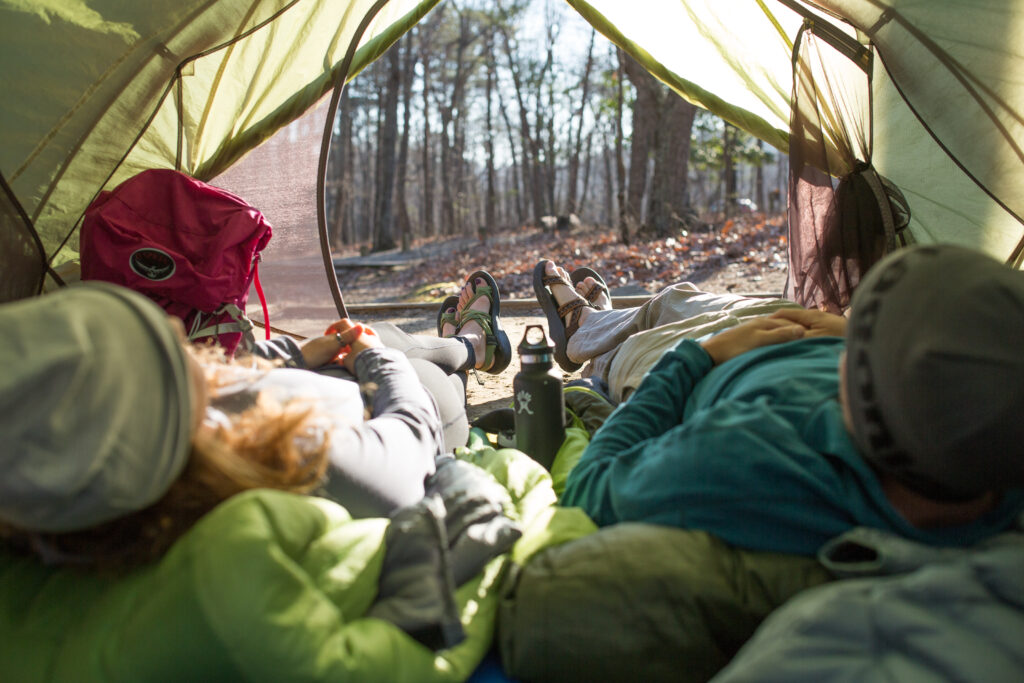Last week we launched our GetCamping! program. We take the excuses out of your long-delayed foray into camping by providing the key equipment: tent, sleeping pads, camp chairs, hammocks, tarp, lights, stove, kitchen gear. You can read more about the specific equipment in the program here.

Now, you may look at that list and think, Is that everything I need to go camping?
It’s not everything. Just the gear you likely don’t have if you’ve never camped. Everything else? You probably have it somewhere in your home. You just haven’t recognized it as camping gear. Here are some examples of stuff you likely have on hand that will substitute nicely on your GetCamping! weekend.
Sleeping bag
A blanket or quilt. Think of sleeping at camp much as you do sleeping at home: You go to bed, you turn down the thermostat, probably into the 60s or even 50s. That’s about what you’re looking at as an overnight low outdoors in fall. And if it gets a little colder, again, do what you would do at home: throw on another blanket.
Pillow
A pillow makes a huge difference in how well you sleep. You needn’t bring the one off your bed; rather, use an old pillow (from the guest room, perhaps) or use a spare pillowcase stuffed with towels.
Kitchen stuff
Our GetCamping! kit includes a two-burner stove, two pots, a place-setting for four. A good start, but you’ll need more: a can openers, cork screw, mixing spoons, spatula, etc. — whatever works in your kitchen will work in camp (provided you don’t need to plug it in). And who among us hasn’t been accumulating basic kitchen stuff over the years: camping provides a good opportunity to retire all those extra spatulas and measure spoons and mixing bowls to your permanent camp kit. Ditto your gear for cleanup: a little dish soap, a sponge, a drying towel.
Food
There are so many ways you can eat in camp. Here, in our experience, are the main three.
- Prepared meals from home. If you like to eat but don’t want to spend a lot of time on food prep on your relaxing camping vacation, consider making meals at home that you can warm in a pot over your camp stove: chili, stew, pasta dishes. Mix up pancake batter beforehand for breakfast pancakes, make wraps at home for lunch.
- Camp cooking. Bring the grill from your home set up, put it over the fire once you’ve got hot coals going and you can eat like a prince, everything from frankfurters to fillets. Wrap corn in the cob or potatoes in tinfoil and toss ‘em in the coals, finish the evening with s’mores. That’s camp eating at its best, and with not a lot of effort on the front end or at camp.
- Eat out of the box. From Pop Tarts first thing in the morning to a bag of Doritos at lunch to beans straight from the can for dinner, this is the most no-fuss option of the batch.
These are some of the key examples of good household substitutes for camping gear. When you sign up for either our Concierge Service or the straight kit rental, you’ll receive our guide, “Car Camping: A Guide to Suitable Substitutes.”
With daytime temperatures in the mid-70s and overnight lows in the mid-50s, fall is the perfect time to give into that long repressed urge to camp. There’s no better place to be than in the outdoors. And no safer place, either.
More on GetCamping!
Check out these previous posts on our GetCamping! program:
- GetCamping! An easy introduction to camping
- GetCamping! 5 Campgrounds Perfect for Fall
